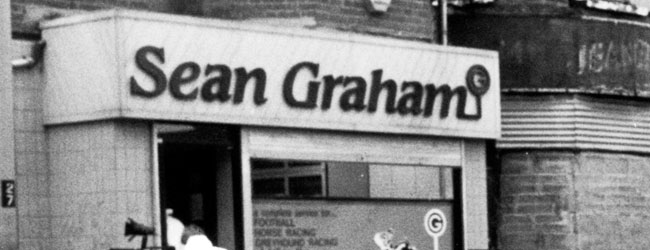1 October 2010
HET leave more questions unanswered
Families to sue PSNI chief
BY LAURA FRIEL
THE families of those shot dead by loyalist gunmen in a Belfast betting shop are suing the PSNI Chief Constable for failing to prevent the killings.
Seán Graham’s bookies on the Ormeau Road became a scene of carnage after two UDA gunmen opened fire at customers in February 1992. Five men were shot dead and seven others were seriously injured.
One of two weapons used in the killings, a Browning pistol, had been given to loyalist paramilitaries by Special Branch. The pistol had been amongst a number of weapons handed over to Special Branch by one of their agents but subsequently returned to the UDA.
A number of police officers who had been in possession of the weapons have been identified, including the officer who handed the weapons to the loyalist killers, but the Public Prosecution Service have refused to prosecute on the grounds that they are ‘unable’ to identify which senior RUC officer made the lethal decision.
The families’ announcement of legal action follows a recent report by the PSNI’s Historical Enquiries Team into the bookies massacre which described the decision by Special Branch as “a significant failure” which had “tragic and devastating” repercussions.
A solicitor acting on behalf of the families of those killed, Kevin Winters, says relatives have been left with no other option than to sue PSNI Chief Constable Matt Baggott.
“Families are being asked to wait years for organisations like the Police Ombudsman and Historic Enquiries Team to carry out investigations without any guarantee of justice.”
Family members of those who died have complained that the HET report released last week did not reveal anything more than is already known. One of the survivors, Mark Sykes, whose teenage brother-in-law was also murdered during the attack on the bookies, expressed concern that two senior officers involved in the case had refused to co-operate with the HET.
“How can the families expect to get any justice when two senior officers, who know more than anyone what happened, will not help with the report?”
The fact that one of the weapons used in the killings was supplied by Special Branch is not the only controversial factor the HET investigation has failed to adequately address.
One of those involved in both the planning of the massacre and escape of the gunmen afterwards was also working as an agent for Special Branch.
In other words, Special Branch had a hand in supplying one of two guns through their agent, William Stobie, for an attack organised by another of their agents, south Belfast UDA commander Stephen McFerran.
McFerran’s status as an agent was confirmed during a court case in 2007. McFerran was on trial in connection with the murder of a fellow loyalist paramilitary in 2003.
But, following the example of other state agents like William Stobie and Brian Nelson before him, McFerran cut a deal, pleading guilty to lesser charges to avoid exposure during a lengthy trial.
McFerran had been involved in more than 20 sectarian murders and, as their military commander in the Ormeau area of south Belfast, he was one of the UDA’s main killers.
But the HET had nothing to say about this. Indeed, they concluded their review “has not uncovered any potential new lines of inquiry”. As a result, “it is unlikely that new investigative opportunities will arise”.
Following a formal request from the victims’ families three years ago, the Police Ombudsman is currently investigating evidence that, as an agent, Stephen McFerran was protected from prosecution.
In 2003, McFerran was implicated in the murder of loyalist paramilitary Roy Green, an associate of Johnny Adair. Although it was widely known that McFerran had lured Green to his death, he was not charged with the murder until 2005.
Before McFerran was arrested and questioned about the killing, Special Branch flew him to England. He later returned to face trial but pleaded guilty to the lesser charge of manslaughter. He was sentenced to five years’ imprisonment and released in 2008.
More curiously still, fingerprints belonging to a member of Special Branch were discovered amongst a cache of weaponry, recovered after a tip-off from McFerran and believed to have been used in the Green murder.
The Browning pistol returned by Special Branch and used in the bookies massacre was also used in a prior sectarian attack in December 1991 when loyalists attacked a Catholic-owned bar, the Devenish Inn. Aiden Wallace was shot dead and other customers seriously wounded, including an 8-year-old who was singled out and shot in the face because he was wearing a Celtic football shirt.
Follow us on Facebook
An Phoblacht on Twitter
Uncomfortable Conversations

An initiative for dialogue
for reconciliation
— — — — — — —
Contributions from key figures in the churches, academia and wider civic society as well as senior republican figures





